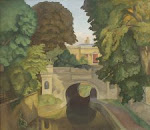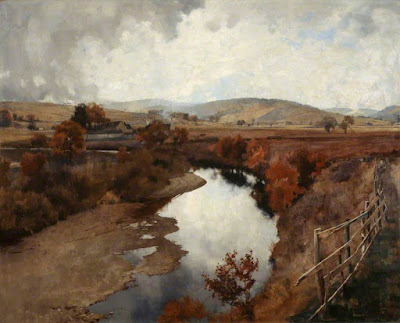The Region November
It is hard to hear the north wind again,
And to watch the treetops, as they sway.
They sway, deeply and loudly, in an effort,
So much less than feeling, so much less than speech,
Saying and saying, the way things say
On the level of that which is not yet knowledge:
A revelation not yet intended.
It is like a critic of God, the world
And human nature, pensively seated
On the waste throne of his own wilderness.
Deeplier, deeplier, loudlier, loudlier,
The trees are swaying, swaying, swaying.
Wallace Stevens, Opus Posthumous (edited by Samuel French Morse) (Alfred A. Knopf 1957). The poem was likely written in 1954, the year prior to Stevens's death at the age of 75. It was not published during his lifetime.
In his final years, Stevens's poems reflected a greater recognition of intimations of Immanence in the self-sufficient, beautiful particulars of the World around him. He had devoted his life to a grand project to construct, through poetry, a "supreme fiction." The defining feature of this project was a constant interplay between Imagination and Reality, an interplay that Stevens regarded as essential to living a fully human life. I am wholly sympathetic with this way of placing oneself into the World. Yet it carries with it a risk of abstraction: the Imagination may assume primacy over Reality.
I think that, toward the end of his life, Stevens harbored doubts about his project. I am not suggesting that he ever abandoned or repudiated it, or his belief in the human importance of the back-and-forth between Imagination and Reality. But one senses a bit of uncertainty, an awareness of other possibilities.
First Warmth
I wonder, have I lived a skeleton's life,
As a questioner about reality,
A countryman of all the bones in the world?
Now, here, the warmth I had forgotten becomes
Part of the major reality, part of
An appreciation of a reality;
And thus an elevation, as if I lived
With something I could touch, touch every way.
Wallace Stevens, Opus Posthumous. The poem was written when Stevens was 67 years old.
But notice the qualification: "as if I lived/With something I could touch, touch every way." (One comes across the phrase "as if" a number of times in Stevens's poetry.) And there is this: "I wonder . . ."
Ian Grant (1904-1993), "Cheshire Mill" (1939)
The change in Stevens can perhaps be appreciated by comparing "The Region November" with one of his best-known poems (which was first published in 1921).
The Snow Man
One must have a mind of winter
To regard the frost and the boughs
Of the pine-trees crusted with snow;
And have been cold a long time
To behold the junipers shagged with ice,
The spruces rough in the distant glitter
Of the January sun; and not to think
Of any misery in the sound of the wind,
In the sound of a few leaves,
Which is the sound of the land
Full of the same wind
That is blowing in the same bare place
For the listener, who listens in the snow,
And, nothing himself, beholds
Nothing that is not there and the nothing that is.
Wallace Stevens, Harmonium (Alfred A. Knopf 1923).
January, not November. But, in both cases, we have a listener, listening to the wind in the trees. One could say that both scenes are marked by bleakness and emptiness. But are they? It is a great deal more complicated than that. Consider a comment made by Stevens in a letter to a scholar who had inquired about the "meaning" of some of his poems: "I shall explain The Snow Man as an example of the necessity of identifying oneself with reality in order to understand it and enjoy it." Wallace Stevens, letter to Hi Simons (April 18, 1944), in Holly Stevens (editor), Letters of Wallace Stevens (Alfred A. Knopf 1966), page 464.
This goes a long way toward explaining the magnificent (and lovely) puzzle of: "For the listener, who listens in the snow,/And, nothing himself, beholds/Nothing that is not there and the nothing that is." "Nothing that is not there." In other words: "Everything is there." If we fail to realize this, we have "a mind of winter" and "have been cold a long time": we are incapable of seeing that we have it in us to construct something out of "the nothing that is," to engage in the never-ending (for the brief time we are here) interplay of Imagination and Reality.
Which leads us to a crucial (and beautiful) line in "The Region November": "A revelation not yet intended." This is where I see a change in Stevens. One is hard put to find Immanence in "The Snow Man": the focus is on "the necessity of identifying oneself with reality in order to understand it and enjoy it." As I said before, this is a perfectly fine way to live. But is it enough? Does it fully account for the "saying and saying" and the "swaying, swaying, swaying" of the trees? They have no need of us, do they? And what, indeed, are they saying? I believe that this is what gave Stevens pause in the final years of his life: the possibility of revelation. But I may be completely wrong.
Josephine Haswell Miller (1890-1975), "The House on the Canal"
At this point, a pause is in order. Long-time (and much-appreciated!) readers of this blog may recall one of my two fundamental poetical precepts: Explanation and explication are the death of poetry. (The other, for those who may be interested, is: It is the individual poem that matters, not the poet.) I fear that I may be veering into forbidden territory with all of this palaver.
Hence, let me be clear: the poems by Wallace Stevens that appear in this post are here because they move me and because I find them beautiful. When all is said and done, you are well-advised to ignore everything that I have said about the poems.
With that, let us turn to another cold, windy, and ostensibly bleak landscape.
The Course of a Particular
Today the leaves cry, hanging on branches swept by wind,
Yet the nothingness of winter becomes a little less.
It is still full of icy shades and shapen snow.
The leaves cry . . . One holds off and merely hears the cry.
It is a busy cry, concerning someone else.
And though one says that one is part of everything,
There is a conflict, there is a resistance involved;
And being part is an exertion that declines:
One feels the life of that which gives life as it is.
The leaves cry. It is not a cry of divine attention,
Nor the smoke-drift of puffed-out heroes, nor human cry.
It is the cry of leaves that do not transcend themselves,
In the absence of fantasia, without meaning more
Than they are in the final finding of the ear, in the thing
Itself, until, at last, the cry concerns no one at all.
Wallace Stevens, Opus Posthumous. The poem was first published in the spring of 1951.
I find this to be one of Stevens's loveliest and most affecting poems, even though I have only the faintest sense of its "meaning." This is, again, a late poem, and the correspondences between it, "The Region November," and "The Snow Man" are remarkable. The Stevens of "The Snow Man" still remains: "It is the cry of leaves that do not transcend themselves,/In the absence of fantasia, without meaning more/Than they are in the final finding of the ear." "Fantasia" is preferable to "a mind of winter."
But the Stevens of "The Region November" is here as well, in this wonderful (and absolutely beautiful) line: "One feels the life of that which gives life as it is." No fantasia is necessary. "Deeplier, deeplier, loudlier, loudlier,/The trees are swaying, swaying, swaying."
Ian Grant, "Winter Scene, Provencal" (1938)
"The thing itself." This phrase appears in "The Course of a Particular." It also appears in the title of the final poem in his final volume: The Collected Poems of Wallace Stevens, which was published on October 1, 1954, the day prior to his seventy-fifth birthday. One presumes that Stevens placed the poem in this position with intent.
He died the following August.
Not Ideas About the Thing But the Thing Itself
At the earliest ending of winter,
In March, a scrawny cry from outside
Seemed like a sound in his mind.
He knew that he heard it,
A bird's cry, at daylight or before,
In the early March wind.
The sun was rising at six,
No longer a battered panache above snow . . .
It would have been outside.
It was not from the vast ventriloquism
Of sleep's faded papier-mâché . . .
The sun was coming from outside.
That scrawny cry -- it was
A chorister whose c preceded the choir.
It was part of the colossal sun,
Surrounded by its choral rings,
Still far away. It was like
A new knowledge of reality.
Wallace Stevens, Collected Poems (Alfred A. Knopf 1954).
"One feels the life of that which gives life as it is."
All the long day --
Yet not long enough for the skylark,
Singing, singing.
Bashō (translated by R. H. Blyth), in R. H. Blyth, Haiku, Volume 2: Spring (Hokuseido Press 1950), page 195.
Josephine Haswell Miller, "Studio Window" (1934)










